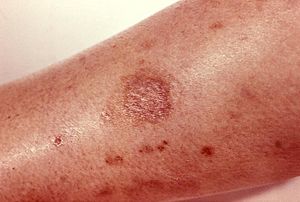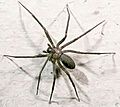Brown recluse spider facts for kids
The brown recluse spider (Loxosceles reclusa) is a shy but dangerous spider found in North America. It's known for its unique violin-shaped mark on its back.
Quick facts for kids Brown recluse spider |
|
|---|---|
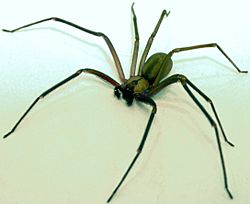 |
|
| A male brown recluse spider | |
| Scientific classification | |
| Kingdom: | |
| Phylum: | |
| Class: | |
| Order: | |
| Family: |
Sicariidae
|
| Genus: |
Loxosceles
|
| Species: |
L. reclusa
|
| Binomial name | |
| Loxosceles reclusa Gertsch & Mulaik, 1940
|
|
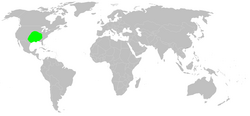 |
|
Contents
About the Brown Recluse Spider
What's in a Name?
The scientific name for the brown recluse spider is Loxosceles reclusa. The first part, Loxosceles, means "slanted leg." This is because their legs touch the ground at an angle. The second part, reclusa, means "recluse" or "shy." This spider is very timid and usually tries to get away from people.
How to Spot One
Brown recluse spiders can be light brown, dark brown, or even gray. Many people call them the violin spider because of a darker mark on their head. This mark looks just like a violin.
Not counting its legs, this spider can grow to about 2 cm (0.79 in) long. That's about the size of a small button. They have six eyes, which is unusual for a spider. Most spiders have eight eyes.
Telling Males from Females
It can be tricky to tell male and female brown recluses apart. You can usually tell once they have molted several times. Spiders have small appendages on their faces called pedipalps.
Male brown recluses have larger ends on their pedipalps. These larger ends are their sex organs. Females have their sex organs on the underside of their body. Scientists can even identify different types of brown recluse spiders by looking closely at these parts.
Where Brown Recluse Spiders Live
Brown recluse spiders are only found in the United States. Spiders in the southwestern U.S. live in the woods. But spiders in the northeastern U.S. often live inside houses.
These spiders like dry, dark places where they can hide easily. In the wild, they live in hollow logs and rotting tree trunks. Inside homes, they often choose garages, basements, and attics. These spots are usually quiet, and they have lots of good hiding places, like cardboard boxes.
Sometimes, these spiders can travel by accident. They might hide inside boxes that people mail. However, spider experts say that brown recluses sent through the mail rarely start new groups in their new homes. This is often because there are no other brown recluses for them to mate with.
What Brown Recluse Spiders Eat
Brown recluse spiders are insectivores. This means they eat insects. They mostly eat soft-bodied insects like moths or flies. They also eat other spiders. They can even be cannibals, meaning they will eat each other! A female brown recluse might even try to eat a male when they are mating.
When a brown recluse hunts, it moves slowly towards its prey. Once it's close enough, it pounces on the prey. Then, it uses its fangs to inject a deadly venom. This venom kills the prey very quickly.
These spiders are very tough. They can go a long time without food or water. Some brown recluses can survive for five seasons without eating or drinking anything.
Brown Recluse Behavior
Brown recluse spiders are hunting spiders. This means they spend most of their time on the ground. They hide and sleep during the day. At night, they come out to hunt for food. They usually don't climb unless they are trying to escape from something.
They can walk upside-down, but most brown recluses you see on ceilings have probably come from an upstairs floor. Their blood doesn't flow through their legs constantly when they walk. So, they have to stop every few seconds to let the blood flow.
These spiders are very good at survival. They can live for over a year without food or water. They are also good at surviving cold winters inside people's homes. If a leg gets caught, like in a crack or by a predator, they can drop the leg. A spider can still walk around with only four legs, as long as it has at least one leg on each side.
Because they are so good at surviving, it's very hard to get rid of them. Regular Bug sprays and pest killers usually don't work well. Some strong chemicals might work, but they are often against the law to use. A spider that has been sprayed might even become more aggressive.
Brown recluse spiders are usually afraid of people. If they see a person, they often stand still. If someone chases them, they will almost always run and hide. Even though they are scared of people, it's not a good idea to try to touch one. Their bite can be very dangerous.
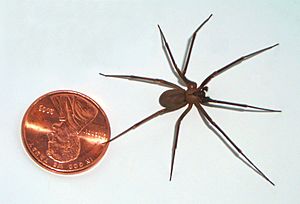
Brown recluses usually only bite if they are being touched. They might also bite if they get stuck between a person and something else. Most brown recluse bites happen when someone puts on clothes that have a spider hiding inside.
If you live in an area with brown recluses, it's a good idea to shake out any clothes that have been on the floor before you put them on. You should also be careful when walking in attics, basements, or dark parts of the house without shoes. Wearing socks or gloves can help, as their fangs are short. Many people live with brown recluses and never see them or get bitten. Good habits can help keep everyone safe.
Brown Recluse Bites: Facts and Myths
People have been worried about brown recluse spiders since they were first identified in 1940. Sometimes, the bite of a brown recluse can lead to a serious skin infection called necrosis. This can cause the skin to break down. While it's very rare, some bites can be very serious. However, most bites from brown recluses are not much worse than a normal spider bite. The bite is most dangerous for very young children or people who are overweight.
Often, when people are bitten by a spider, they go to the doctor without bringing the spider. When this happens, doctors have to guess what kind of spider caused the bite. The brown recluse spider is often blamed because its name is well-known. But it's very rare that a brown recluse spider was actually involved.
This guesswork has made many people believe brown recluses live in places where they don't, like California. This is not true. It is common for a brown recluse to bite someone, and that person might not feel any symptoms for many hours or even days. In most cases, if someone has serious symptoms, it's usually caused by a different kind of spider or even a disease.
Scientists are still learning a lot about the venom of the brown recluse. Experts are working to find ways to tell for sure if a brown recluse has bitten someone. They are also looking for an antidote to its venom.
Images for kids
See also
 In Spanish: Araña ermitaña parda para niños
In Spanish: Araña ermitaña parda para niños


